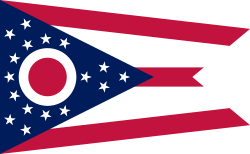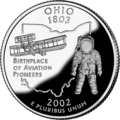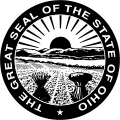Ohio
Ohio is one of the 50 states in the United States. Its capital is Columbus. Columbus is also the largest city in Ohio.
| State of Ohio | |
|
| |
|
| |
| Anthem: Beautiful Ohio (1969)[2] Hang On Sloopy (1985)[3] | |
 Map of the United States with Ohio highlighted | |
| Country | United States |
| Admitted to the Union | March 1, 1803 (17th, declared retroactively on August 7, 1953[4]) |
| Capital (and largest city) | Columbus[5] |
| Largest metro | Greater Cincinnati Greater Columbus (see footnotes)[6] |
| Government | |
| • Governor | Mike DeWine (R) |
| • Lieutenant Governor | Jon A. Husted (R) |
| Legislature | General Assembly |
| • Upper house | Senate |
| • Lower house | House of Representatives |
| U.S. senators | Sherrod Brown (D) Rob Portman (R) |
| U.S. House delegation | 12 Republicans 4 Democrats (list) |
| Area | |
| • Total | 44,825 sq mi (116,096 km2) |
| • Land | 40,948 sq mi (106,156 km2) |
| • Water | 3,877 sq mi (10,040 km2) 8.7% |
| • Rank | 34th |
| Elevation | 850 ft (260 m) |
| Highest elevation | 1,549 ft (472 m) |
| Lowest elevation | 455 ft (139 m) |
| Population (2019) | |
| • Total | 11,689,100 |
| • Rank | 7th |
| • Density | 282/sq mi (109/km2) |
| • Rank | 10th |
| • Median household income | $54,021[9] |
| • Income rank | 36th |
| Language | |
| • Official language | De jure: None De facto: English |
| • Spoken language | English 93.3% Spanish 2.2% Other 4.5%[10] |
| Time zone | UTC−05:00 (Eastern) |
| • Summer (DST) | UTC−04:00 (EDT) |
| USPS abbreviation | OH[11] |
| ISO 3166 code | US-OH |
| Trad. abbreviation | O., Oh. |
| Latitude | 38°24′ N to 41°59′ N |
| Longitude | 80°31′ W to 84°49′ W |
| Website | ohio |
| Ohio state symbols | |
|---|---|
 | |
 | |
| Living insignia | |
| Amphibian | Spotted salamander |
| Bird | Cardinal (1933)[2] |
| Flower | Red carnation (1904)[2] |
| Insect | Ladybug (1975)[2] |
| Mammal | White-tailed deer (1987)[2] |
| Reptile | Black racer snake (1995)[2] |
| Tree | Buckeye (1953)[2] |
| Inanimate insignia | |
| Beverage | Tomato juice (1965)[2] |
| Fossil | Isotelus maximus, a trilobite (1985)[2] |
| Gemstone | Ohio flint (1965)[2] |
| Slogan | So Much to Discover |
| Other | Wild flower: Great white trillium (1986)[2] Fruit: Pawpaw |
| State route marker | |
 | |
| State quarter | |
 Released in 2002 | |
| Lists of United States state symbols | |
Other large cities in Ohio are Cleveland, Cincinnati, Dayton, Akron, Toledo, and Youngstown.
Some famous people from Ohio include golfer Jack Nicklaus, Wilbur and Orville Wright, astronauts John Glenn and Neil Armstrong, authors Sherwood Anderson and Toni Morrison,[12] and actors Clark Gable and Katie Holmes. There have also been seven American presidents from Ohio: Ulysses S. Grant, Rutherford Hayes, James Garfield, Benjamin Harrison, William McKinley, William Howard Taft, Warren G. Harding.
Ohio is important in elections because it is a swing state. Candidates often campaign a lot there and prior to 2020, the last time they voted for the losing candidate was 1960. Also, no Republican has ever won the presidency without carrying this state. Ohio has both farmland and cities, and there is a lot of discrimination against black people.[13] It is a part of the Midwest. Ohio is the 7th most populated state in the United States of America.
Geography
Ohio borders Pennsylvania, Michigan, Indiana, Kentucky, and West Virginia, and it shares a water border with Ontario, Canada. Western Ohio is mostly flat farmland, with some hills. Southern and Southeastern Ohio is near the Appalachian Mountains, and is the most mountainous part of the state. Most of this area is covered by forests. This part of Ohio is home to the Ohio River, the Wayne National Forest, and the Hocking Hills, which has waterfalls and canyons.
Central Ohio is mostly rolling hills, and is home to Columbus. Northeast Ohio is dominated by the Lake Erie coast and has a mix of cities and countryside.
Economy
For many years, industry and manufacturing was the biggest part of Ohio's economy. Youngstown was a big steel producer, as was Cleveland. Other manufacturing - including the car industry - was a major factor across the state. Since the 1970s, industry has shrank in Ohio, but it is still a big part of the local economy. Today, other businesses are more prominent. Cleveland is one of the biggest hubs for Healthcare, and its main hospital, the famous Cleveland Clinic, is the largest employer in the region. Banking is also a major business, and foods and retail are too. Cincinnati plays host to the headquarters of Fifth Third Bank, Cintas, Kroger, Luxottica, Procter & Gamble and Macy's, whereas, Columbus hosts the headquarters of LBrands, JPMorgan Chase, Huntington Bank, Rogue Fitness, Wendy's, Big Lots, Cardinal Health and Nationwide Insurance. In addition The J.M. Smucker Company and Key Bank are also based in Ohio.
Related pages
References
| Wikimedia Commons has media related to Lua error in Module:Commons_link at line 62: attempt to index field 'wikibase' (a nil value).. |
- ↑ "Ohio's State Motto". Ohio Historical Society. July 1, 2005. Archived from the original on October 6, 2007. Retrieved March 27, 2009.
- ↑ 2.00 2.01 2.02 2.03 2.04 2.05 2.06 2.07 2.08 2.09 2.10 "Ohio's State Symbols". Ohio Governor's Residence and State Garden. Archived from the original on April 23, 2009. Retrieved March 26, 2009.
- ↑ "Ohio's State Rock Song". Ohio Historical Society. July 1, 2005. Archived from the original on February 7, 2009. Retrieved March 27, 2009.
- ↑ "The Admission of Ohio as a State". United States House of Representatives. Archived from the original on November 10, 2019. Retrieved November 10, 2019.
- ↑ "Ohio Quick Facts". Ohio Historical Society. Archived from the original on February 8, 2009. Retrieved March 26, 2009.
- ↑ According to the U.S. Census July 2017 Annual Estimate , Greater Columbus is the largest Metropolitan statistical area (MSA) that is entirely within Ohio, with a population of 2,078,725; and Greater Cincinnati is the largest MSA that is at least partially within Ohio, with a population of 2,179,082, approximately 25% of which is in Indiana or Kentucky. Which MSA is the largest in Ohio depends on the context.
- ↑ 7.0 7.1 "Elevations and Distances in the United States". United States Geological Survey. 2001. Archived from the original on July 22, 2012. Retrieved October 24, 2011.
- ↑ 8.0 8.1 Elevation adjusted to North American Vertical Datum of 1988.
- ↑ "Median Annual Household Income". The Henry J. Kaiser Family Foundation. Archived from the original on December 20, 2016. Retrieved December 9, 2016.
- ↑ Bureau, U.S. Census. "American FactFinder—Results". factfinder2.census.gov. Archived from the original on February 12, 2020. Retrieved October 17, 2012.
- ↑ "Official USPS Abbreviations". United States Postal Service. 1998. Archived from the original on March 28, 2009. Retrieved March 26, 2009.
- ↑ Yost, Laina; Woytach, Carissa (2019-08-06). "'She treasured Lorain, we treasured her': Nobel laureate Toni Morrison dies at 88 (UPDATED/PHOTOS)". The Chronicle-Telegram. Archived from the original on 2019-08-07. Retrieved 2020-10-31.
- ↑ "Report: Segregation and discrimination plague Midwest". Policy Matters Ohio. 2019-10-10. Retrieved 2020-10-31.
Ohio, where 12.3% of residents are black, struggles in several key indicators. The state's difference between the black and white unemployment rate is 5th largest in the nation. The gap between what Ohio employers pay white and black workers is larger than in all but 41 states. More than a quarter of black Ohioans who are poor live in high-poverty neighborhoods. In Cleveland and Dayton, concentrated poverty among black people exceeds 40%.
{{cite web}}: CS1 maint: url-status (link)
